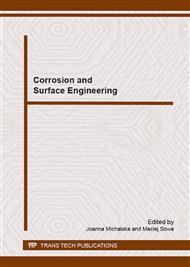p.35
p.39
p.43
p.47
p.51
p.55
p.59
p.63
p.67
Corrosion Resistance of Sinters CNT-Cu/Cu
Abstract:
Copper and its alloys are used in many industrial and marine applications due to their good heat transfer and electrical properties. Copper is, however, susceptible to many forms of corrosion, including localized corrosion, such as crevice corrosion. The paper presents the preliminary results of studies on obtaining copper-based composite materials strengthened with carbon nanotubes modified with copper nanoparticles. The nanotubes modification was carried out by chemically attaching copper nanopaticles originating from copper acetate. Electrolytically obtained copper powders were used as the matrix. The materials were consolidated by one-sides pressing followed by sintering. One of the important property of these materials is its resistance to corrosion. Potentiokinetic investigations in a 3.5% NaCl solution were performed on specimens of different CNTs content. Determined what influence on the corrosive changes has the addition of nanotubes to copper.
Info:
Periodical:
Pages:
51-54
Citation:
Online since:
January 2015
Keywords:
Price:
Сopyright:
© 2015 Trans Tech Publications Ltd. All Rights Reserved
Share:
Citation:


